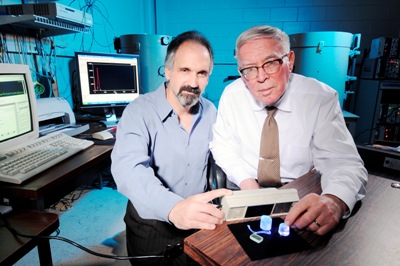A research team comprising Brent Wagner and Bernd Kahn from the Georgia Tech Research Institute (GTRI) has devised a prototype called the nano-photonic composite scintillation detector that integrates rare-earth metals and other elements at the nanoscale for enhanced strength, accuracy and sensitivity to provide improved radiation detection.
 Georgia Tech Research Institute researchers Brent Wagner and Bernd Kahn are using novel materials and nanotechnology techniques to develop improved radiation detection techniques. (Credit: Gary Meek)
Georgia Tech Research Institute researchers Brent Wagner and Bernd Kahn are using novel materials and nanotechnology techniques to develop improved radiation detection techniques. (Credit: Gary Meek)
Solid-state detectors and scintillation detectors are the two technologies used for detecting subatomic particles and gamma rays released by nuclear materials. However, these technologies have their own limitations and problems. To overcome these issues, the GTRI team has been exploring various novel materials and technologies.
For its research, the GTRI team chose the scintillation technology that uses a single crystal made of sodium iodide or similar materials. The team then synthesized a composite material that can generate light and were made of nanoparticles of rare-earth metals, oxides, and halides.
Wagner explained that a scintillator crystal must have light transparency to sense radiation. An ideal crystal produces flashes of light by uniformly transforming the energy from incoming gamma rays. These flashes of light are then amplified by a photo-multiplier to enable the accurate measurement of the light for obtaining the radioactivity information.
Transparent materials like glass or crystal will lose their transparency when they broke into tiny pieces. To tackle this problem, the research team powdered the materials to the nanoscale, which in turn lowers the scattering effects as the particles’ size is considerably smaller than the incoming gamma rays’ wavelength.
Initially, the GTRI team used a plastic matrix to disperse the radiation-sensitive crystalline nanoparticles. However, the team was not able to evenly distribute the nanopowder in the matrix to get accurate radiation readings.
Hence, the team used glass as a matrix material by adding cerium bromide and gadolinium with alumina and silica. In this combination, gadolinium absorbs the gamma energy and transmits the energy cerium, which works as an efficient light emitter. The team was able to uniformly distribute the cerium and gadolinium in silica glasses by heating cerium, gadolinium, alumina and silica to a molten mix, which then cooled down as a solid monolith. The cooling of the mix precipitated the cerium and gadolinium out of aluminosilicate solution, causing their uniform distribution in the glass. The resulting material gives reliable readings during its exposure to the gamma rays.